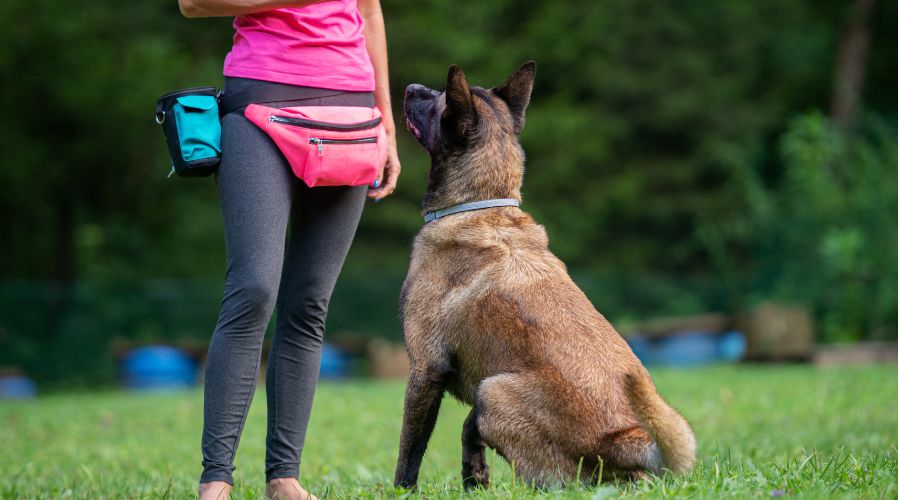These commands can help keep the dog safe, well-behaved, and make it easier to communicate with them.

One of the most common sets of commands that dog trainers recommend are the “7 Common Commands”.
These commands are essential for any dog to learn and include Sit, Stay, Come, Heel, Down, Leave It, and Place. Each of these commands serves a specific purpose and can be used in different situations.
For example, the Sit command can be used to calm a dog down, the Stay command can be used to keep the dog in one place, and the Come command can be used to call the dog back to its owner.
By teaching a dog these commands, owners can establish themselves as the pack leader and build a stronger bond with their pet.
While these commands may seem simple, they require patience, consistency, and practice to master. Luckily, there are plenty of resources available for dog owners who want to train their pets.
From online tutorials to in-person classes, dog owners have many options for learning how to teach their dogs these essential commands. With the right training and plenty of praise and treats, any dog can learn the 7 Common Commands and become a well-behaved and happy member of the family.
Table of Contents
What are the 7 common dog commands?
According to various sources, the 7 common dog commands are: sit, stay, come, heel, down, off, and leave it.
The 7 Common Dog Commands
Sit
Teach your dog to sit by holding a treat close to their nose, then lifting it up and back over their head. As their head follows the treat, their butt will naturally lower. Say “sit” as they do so.
Stay
Start by having your dog sit. Then, with your palm facing out, say “stay” while taking a step back. Gradually increase the distance and duration of the stay.
Come
Use a long leash and say “come” while gently pulling your dog towards you. Reward them when they reach you. Repeat until they come without the leash.
Down
Start with your dog in a sitting position. Hold a treat in front of their nose and slowly move it towards the ground. Say “down” as they lower themselves to the ground.
Heel
With your dog on a leash, say “heel” and start walking. Keep the leash short and close to your body. Reward them for walking beside you.
Off
Say “off” when your dog jumps up on something they shouldn’t. Turn away from them and ignore them until they stop. Then reward them for stopping.
Leave It
Hold a treat in your closed fist. Say “leave it” and wait for them to stop trying to get the treat. Reward them when they do.
That’s it! These 7 common commands will help establish a strong foundation for an obedient and well-behaved dog.
How to Train Your Dog to Follow Commands
Positive Reinforcement
- Reward good behavior with treats, praise, or playtime.
- Avoid punishment or negative reinforcement.
- Encourage your dog to repeat good behavior.
Consistency
- Use the same commands and cues every time.
- Train in the same location with minimal distractions.
- Everyone in the household should use the same commands.
Short Training Sessions
- Train for short periods, 5-10 minutes at a time.
- Train frequently, 2-3 times a day.
- End training sessions on a positive note.
Patience
- Be patient with your dog’s progress.
- Don’t expect immediate results.
- Adjust training techniques as needed.
Rewards
- Use high-value treats for good behavior.
- Gradually reduce the frequency of treats.
- Use playtime or praise as rewards.
Conclusion
Teaching your dog the seven basic commands is essential for their safety and your peace of mind.
These commands not only help you establish a good relationship with your dog but also ensure that they can function as an upstanding member of society.
Here are a few key takeaways from this article:
- Consistency is key when training your dog. Make sure to use the same commands and rewards every time.
- Positive reinforcement is the most effective way to train your dog. Use treats and praise to encourage good behavior.
- Be patient and persistent. It may take some time for your dog to learn these commands, but with practice, they will eventually get it.
- Remember to keep training sessions short and fun. Dogs learn best when they are having fun and enjoying the process.
By teaching your dog these seven basic commands, you can ensure that they are well-behaved and obedient. Whether you have a new puppy or an older dog, it’s never too late to start training.
With a little bit of time and effort, you can have a happy and well-trained furry friend by your side.
